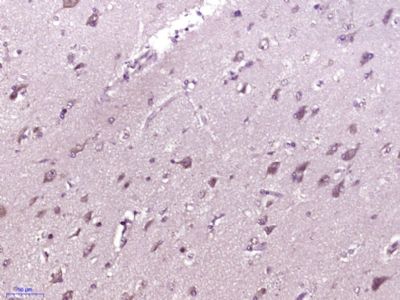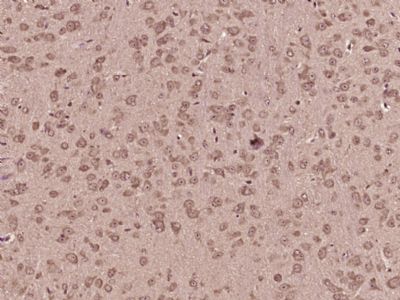PISD Polyclonal Antibody
Purified Rabbit Polyclonal Antibody (Pab)
- SPECIFICATION
- CITATIONS
- PROTOCOLS
- BACKGROUND

Application
| WB, IHC-P, IHC-F, IF, ICC, E |
|---|---|
| Primary Accession | Q9UG56 |
| Reactivity | Rat, Pig, Dog |
| Host | Rabbit |
| Clonality | Polyclonal |
| Calculated MW | 47 KDa |
| Physical State | Liquid |
| Immunogen | KLH conjugated synthetic peptide derived from human PISD |
| Epitope Specificity | 151-250/409 |
| Isotype | IgG |
| Purity | affinity purified by Protein A |
| Buffer | 0.01M TBS (pH7.4) with 1% BSA, 0.02% Proclin300 and 50% Glycerol. |
| SUBCELLULAR LOCATION | Mitochondrion. |
| SIMILARITY | Belongs to the phosphatidylserine decarboxylase family. |
| SUBUNIT | Heterodimer |
| Important Note | This product as supplied is intended for research use only, not for use in human, therapeutic or diagnostic applications. |
| Background Descriptions | Enzymes known as phosphatidylserine decarboxylases (PSDs) catalyze the formation of phosphatidylethanolamine from phosphatidylserine via phosphatidylserine decarboxylation. Type I PSDs contain LGST motifs and are found in bacteria and eukaryotic mitochondria, whereas type II PSDs contain GGST motifs and are found in eukaryotic endomembrane systems. PISD (phosphatidylserine decarboxylase), also known as phosphatidylserine decarboxylase proenzyme, PSDC, PSD, PSSC, DJ858B16, dJ858B16.2 or DKFZp566G2246, is a 408 amino acid a type I phosphatidylserine decarboxylase that localizes to the inner mitochondrial membrane. PISD contains a conserved LGST motif which is cleaved to produce two isoforms known as PISD α and PISD β. PISD is capable of forming a heterodimer and is highly expressed in liver and testis. The gene encoding PISD maps to human chromosome 22q12.2. |
| Gene ID | 23761 |
|---|---|
| Other Names | Phosphatidylserine decarboxylase proenzyme, mitochondrial {ECO:0000255|HAMAP-Rule:MF_03208}, 4.1.1.65 {ECO:0000255|HAMAP-Rule:MF_03208}, Phosphatidylserine decarboxylase beta chain {ECO:0000255|HAMAP-Rule:MF_03208}, Phosphatidylserine decarboxylase alpha chain {ECO:0000255|HAMAP-Rule:MF_03208}, PISD {ECO:0000255|HAMAP-Rule:MF_03208} |
| Dilution | WB=1:500-2000,IHC-P=1:100-500,IHC-F=1:100-500,ICC=1:100-500,IF=1:100-500,ELISA=1:5000-10000 |
| Storage | Store at -20 ℃ for one year. Avoid repeated freeze/thaw cycles. When reconstituted in sterile pH 7.4 0.01M PBS or diluent of antibody the antibody is stable for at least two weeks at 2-4 ℃. |
| Name | PISD {ECO:0000255|HAMAP-Rule:MF_03208} |
|---|---|
| Function | Catalyzes the formation of phosphatidylethanolamine (PtdEtn) from phosphatidylserine (PtdSer) (PubMed:30488656, PubMed:30858161). Plays a central role in phospholipid metabolism and in the interorganelle trafficking of phosphatidylserine. May be involved in lipid droplet biogenesis at the endoplasmic reticulum membrane (By similarity). |
| Cellular Location | [Phosphatidylserine decarboxylase beta chain]: Mitochondrion inner membrane {ECO:0000255|HAMAP-Rule:MF_03208, ECO:0000305|PubMed:30858161, ECO:0000305|PubMed:33718843}; Single-pass membrane protein {ECO:0000255|HAMAP-Rule:MF_03208}; Intermembrane side {ECO:0000255|HAMAP-Rule:MF_03208} [Isoform 1]: Mitochondrion inner membrane |

Thousands of laboratories across the world have published research that depended on the performance of antibodies from Abcepta to advance their research. Check out links to articles that cite our products in major peer-reviewed journals, organized by research category.
info@abcepta.com, and receive a free "I Love Antibodies" mug.
Provided below are standard protocols that you may find useful for product applications.
If you have used an Abcepta product and would like to share how it has performed, please click on the "Submit Review" button and provide the requested information. Our staff will examine and post your review and contact you if needed.
If you have any additional inquiries please email technical services at tech@abcepta.com.













 Foundational characteristics of cancer include proliferation, angiogenesis, migration, evasion of apoptosis, and cellular immortality. Find key markers for these cellular processes and antibodies to detect them.
Foundational characteristics of cancer include proliferation, angiogenesis, migration, evasion of apoptosis, and cellular immortality. Find key markers for these cellular processes and antibodies to detect them. The SUMOplot™ Analysis Program predicts and scores sumoylation sites in your protein. SUMOylation is a post-translational modification involved in various cellular processes, such as nuclear-cytosolic transport, transcriptional regulation, apoptosis, protein stability, response to stress, and progression through the cell cycle.
The SUMOplot™ Analysis Program predicts and scores sumoylation sites in your protein. SUMOylation is a post-translational modification involved in various cellular processes, such as nuclear-cytosolic transport, transcriptional regulation, apoptosis, protein stability, response to stress, and progression through the cell cycle. The Autophagy Receptor Motif Plotter predicts and scores autophagy receptor binding sites in your protein. Identifying proteins connected to this pathway is critical to understanding the role of autophagy in physiological as well as pathological processes such as development, differentiation, neurodegenerative diseases, stress, infection, and cancer.
The Autophagy Receptor Motif Plotter predicts and scores autophagy receptor binding sites in your protein. Identifying proteins connected to this pathway is critical to understanding the role of autophagy in physiological as well as pathological processes such as development, differentiation, neurodegenerative diseases, stress, infection, and cancer.



